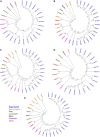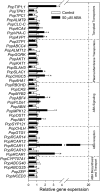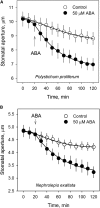Evolutionary Conservation of ABA Signaling for Stomatal Closure
- PMID: 28232585
- PMCID: PMC5462018
- DOI: 10.1104/pp.16.01848
Evolutionary Conservation of ABA Signaling for Stomatal Closure
Abstract
Abscisic acid (ABA)-driven stomatal regulation reportedly evolved after the divergence of ferns, during the early evolution of seed plants approximately 360 million years ago. This hypothesis is based on the observation that the stomata of certain fern species are unresponsive to ABA, but exhibit passive hydraulic control. However, ABA-induced stomatal closure was detected in some mosses and lycophytes. Here, we observed that a number of ABA signaling and membrane transporter protein families diversified over the evolutionary history of land plants. The aquatic ferns Azolla filiculoides and Salvinia cucullata have representatives of 23 families of proteins orthologous to those of Arabidopsis (Arabidopsis thaliana) and all other land plant species studied. Phylogenetic analysis of the key ABA signaling proteins indicates an evolutionarily conserved stomatal response to ABA. Moreover, comparative transcriptomic analysis has identified a suite of ABA-responsive genes that differentially expressed in a terrestrial fern species, Polystichum proliferum These genes encode proteins associated with ABA biosynthesis, transport, reception, transcription, signaling, and ion and sugar transport, which fit the general ABA signaling pathway constructed from Arabidopsis and Hordeum vulgare The retention of these key ABA-responsive genes could have had a profound effect on the adaptation of ferns to dry conditions. Furthermore, stomatal assays have shown the primary evidence for ABA-induced closure of stomata in two terrestrial fern species Pproliferum and Nephrolepis exaltata In summary, we report, to our knowledge, new molecular and physiological evidence for the presence of active stomatal control in ferns.
© 2017 American Society of Plant Biologists. All Rights Reserved.
Figures








Similar articles
-
Fern Stomatal Responses to ABA and CO2 Depend on Species and Growth Conditions.Plant Physiol. 2017 Jun;174(2):672-679. doi: 10.1104/pp.17.00120. Epub 2017 Mar 28. Plant Physiol. 2017. PMID: 28351911 Free PMC article.
-
Conditional stomatal closure in a fern shares molecular features with flowering plant active stomatal responses.Curr Biol. 2021 Oct 25;31(20):4560-4570.e5. doi: 10.1016/j.cub.2021.08.008. Epub 2021 Aug 26. Curr Biol. 2021. PMID: 34450089
-
Gaining or cutting SLAC: the evolution of plant guard cell signalling pathways.New Phytol. 2024 Dec;244(6):2295-2310. doi: 10.1111/nph.20172. Epub 2024 Oct 6. New Phytol. 2024. PMID: 39370767 Free PMC article.
-
Signaling Transduction of ABA, ROS, and Ca2+ in Plant Stomatal Closure in Response to Drought.Int J Mol Sci. 2022 Nov 26;23(23):14824. doi: 10.3390/ijms232314824. Int J Mol Sci. 2022. PMID: 36499153 Free PMC article. Review.
-
Mechanism of Stomatal Closure in Plants Exposed to Drought and Cold Stress.Adv Exp Med Biol. 2018;1081:215-232. doi: 10.1007/978-981-13-1244-1_12. Adv Exp Med Biol. 2018. PMID: 30288712 Review.
Cited by
-
Exploring beneficial effects of phytobiotics in marine shrimp farming: A review.Heliyon. 2024 May 10;10(14):e31074. doi: 10.1016/j.heliyon.2024.e31074. eCollection 2024 Jul 30. Heliyon. 2024. PMID: 39113972 Free PMC article. Review.
-
Roles of Chloroplast Retrograde Signals and Ion Transport in Plant Drought Tolerance.Int J Mol Sci. 2018 Mar 23;19(4):963. doi: 10.3390/ijms19040963. Int J Mol Sci. 2018. PMID: 29570668 Free PMC article. Review.
-
Molecular and Evolutionary Mechanisms of Cuticular Wax for Plant Drought Tolerance.Front Plant Sci. 2017 Apr 28;8:621. doi: 10.3389/fpls.2017.00621. eCollection 2017. Front Plant Sci. 2017. PMID: 28503179 Free PMC article. Review.
-
Transcriptome Profile Analysis of Arabidopsis Reveals the Drought Stress-Induced Long Non-coding RNAs Associated With Photosynthesis, Chlorophyll Synthesis, Fatty Acid Synthesis and Degradation.Front Plant Sci. 2021 May 25;12:643182. doi: 10.3389/fpls.2021.643182. eCollection 2021. Front Plant Sci. 2021. PMID: 34113361 Free PMC article.
-
The Mechanism of Metal Homeostasis in Plants: A New View on the Synergistic Regulation Pathway of Membrane Proteins, Lipids and Metal Ions.Membranes (Basel). 2021 Dec 15;11(12):984. doi: 10.3390/membranes11120984. Membranes (Basel). 2021. PMID: 34940485 Free PMC article. Review.
References
-
- Beerling DJ, Franks PJ (2009) Evolution of stomatal function in ‘lower’ land plants. New Phytol 183: 921–925 - PubMed
-
- Berry JA, Beerling DJ, Franks PJ (2010) Stomata: key players in the earth system, past and present. Curr Opin Plant Biol 13: 233–240 - PubMed
-
- Blatt MR. (2000) Cellular signaling and volume control in stomatal movements in plants. Annu Rev Cell Dev Biol 16: 221–241 - PubMed
-
- Blatt MR, Armstrong F (1993) K+ channels of stomatal guard cells: abscisic-acid-evoked control of the outward rectifier mediated by cytoplasmic pH. Planta 191: 330–341
-
- Blatt MR, Thiel G, Trentham DR (1990) Reversible inactivation of K+ channels of Vicia stomatal guard cells following the photolysis of caged inositol 1,4,5-trisphosphate. Nature 346: 766–769 - PubMed
MeSH terms
Substances
Grants and funding
LinkOut - more resources
Full Text Sources
Other Literature Sources

